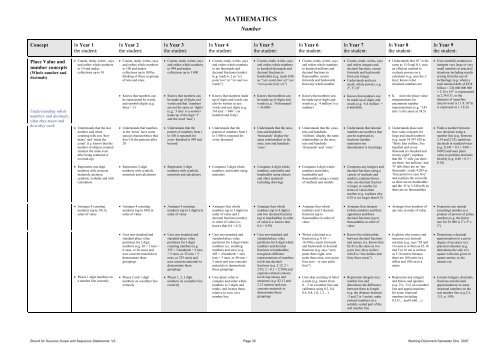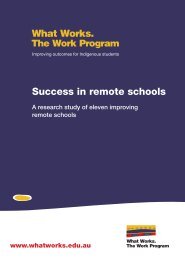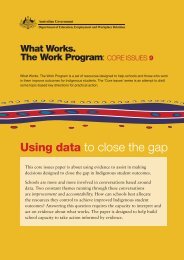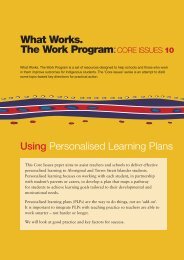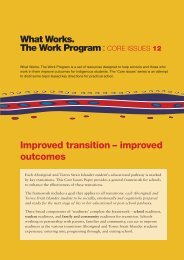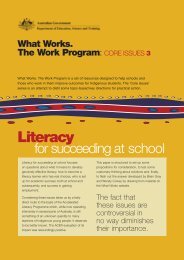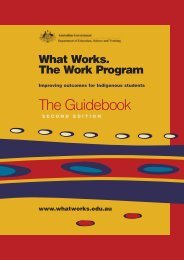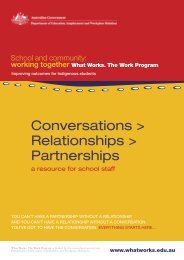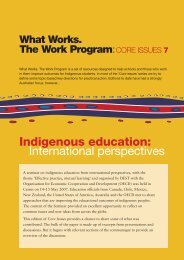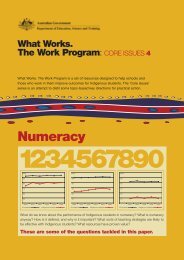Bound for Success Scope and Sequence Statements
Bound for Success Scope and Sequence Statements
Bound for Success Scope and Sequence Statements
- No tags were found...
Create successful ePaper yourself
Turn your PDF publications into a flip-book with our unique Google optimized e-Paper software.
MATHEMATICSNumberConcept In Year 1the student:In Year 2the student:In Year 3the student:In Year 4the student:In Year 5the student:In Year 6the student:In Year 7the student:In Year 8the student:In Year 9the student:Place Value <strong>and</strong>number concepts(Whole number <strong>and</strong>decimals)Underst<strong>and</strong>ing wholenumbers <strong>and</strong> decimals;what they mean <strong>and</strong>how they work• Counts, reads, writes , says<strong>and</strong> orders whole numbersto 10 <strong>and</strong> makescollections up to 10• Underst<strong>and</strong>s that the lastnumber said whencounting tells you ‘howmany’ <strong>and</strong> ‘trusts thecount’ (i.e. knows that thenumber of objects countedremains the same evenafter being scattered orcovered-up)• Represents one-digitnumbers with concretematerials, pictures,symbols, verbally <strong>and</strong> withcalculators• Counts, reads, writes, says<strong>and</strong> orders whole numbersto 100 <strong>and</strong> makescollections up to 100 bythinking of these as groupsof tens <strong>and</strong> ones• Knows that numbers canbe represented by words<strong>and</strong> symbols/digits (e.g.three = 3)• Underst<strong>and</strong>s that numbersin the ‘teens’ have somespecial characteristics thatdon’t fit the patterns after20• Represents 2-digitnumbers with symbols,materials <strong>and</strong> calculators• Counts, reads, writes, says<strong>and</strong> orders whole numbersto 999 <strong>and</strong> makescollections up to 1 000• Knows that numbers canbe made up of digits <strong>and</strong>words <strong>and</strong> that ‘numbers’are not the same as ‘digits’(e.g. ‘3 tens’ is a numbermade up of the digit ‘3’<strong>and</strong> the word ‘tens’)• Underst<strong>and</strong>s that thepattern of numbers from 1to 100 is repeated <strong>for</strong>every hundred to 999 <strong>and</strong>beyond• Represents 3-digitnumbers with symbols,materials <strong>and</strong> calculators• Counts, reads, writes, says<strong>and</strong> orders whole numbersto ten thous<strong>and</strong>s <strong>and</strong>decimal fractions (tenths)(e.g. reads 6..2 as “sixpoint two” or “six <strong>and</strong> twotenths”)• Knows that numbers madeup of digits <strong>and</strong> words canalso be written as justwords <strong>and</strong> just digits (e.g.’64 tens’ = 640 = sixhundred <strong>and</strong> <strong>for</strong>ty)• Underst<strong>and</strong>s that thepattern of numbers from 1to 1 000 is repeated <strong>for</strong>every thous<strong>and</strong>• Compares 3-digit wholenumbers, <strong>and</strong> tenths usingmaterials• Counts, reads, writes, says<strong>and</strong> orders whole numbersto hundred thous<strong>and</strong>s <strong>and</strong>decimal fractions tohundredths (e.g. reads 0.46as “zero point four six” not“zero point <strong>for</strong>ty six”)• Knows that numbers canbe made up of digits <strong>and</strong>words (e.g. ’36 thous<strong>and</strong>’= 36 000)• Underst<strong>and</strong>s that the ones,tens <strong>and</strong> hundreds‘thous<strong>and</strong>s’ display thesame relationships as theones, tens <strong>and</strong> hundreds‘ones’• Compares 4-digit wholenumbers, <strong>and</strong> tenths <strong>and</strong>hundredths using objects<strong>and</strong> other materialsincluding drawings• Counts, reads, writes, says<strong>and</strong> orders whole numbersto hundred millions <strong>and</strong>decimal fractions tothous<strong>and</strong>ths; counts<strong>for</strong>wards <strong>and</strong> backwardsfrom any whole number• Knows that numbers canbe made up of digits <strong>and</strong>words (e.g. ‘4 million’ is anumber)• Underst<strong>and</strong>s that the ones,tens <strong>and</strong> hundreds‘millions’ display the samerelationships as the ones,tens <strong>and</strong> hundreds‘thous<strong>and</strong>s’ <strong>and</strong> ‘ones’• Compares 6-digit wholenumbers <strong>and</strong> tenths,hundredths <strong>and</strong>thous<strong>and</strong>ths using a varietyof methods <strong>and</strong> models• Counts, reads, writes, says<strong>and</strong> orders integers <strong>and</strong>decimal fractions; counts<strong>for</strong>wards <strong>and</strong> backwardsfrom any integer• Underst<strong>and</strong>s <strong>and</strong> usessmall, whole powers, e.g.2 3 , 3 5 ,10 3• Knows that numbers canbe made up of digits <strong>and</strong>words (e.g. ‘6.4 million’ =6 400 000)• Underst<strong>and</strong>s that rationalnumbers are numbers thatcan be expressed asfractions (neithernumerator nordenominator is recurring)• Compares any integers <strong>and</strong>decimal fractions using avariety of methods <strong>and</strong>models; explains/showswhy one decimal fractionis larger or smaller (interms of value) thananother (e.g. explains why0.29 is not larger than 0.3)• Underst<strong>and</strong>s that 10 -1 is thesame as 1/10 <strong>and</strong> 0.1; usesan efficient method toevaluate powers on acalculator (e.g. uses the x ykey); knows whatirrational numbers are• K nows the place valueinterpretations <strong>for</strong>uncommon numberrepresentations (e.g. ‘3.45tens’ is the same as 34.5)• Underst<strong>and</strong>s place <strong>and</strong>face value concepts <strong>for</strong>large <strong>and</strong> small numbers(e.g. reads 34 597 628 as“thirty four million, fivehundred <strong>and</strong> seventhous<strong>and</strong> six hundred <strong>and</strong>twenty eight”, explainsthat the ‘3’ tells you thereare three ‘ten millions’ <strong>and</strong>‘0’ tells there are no ‘tenthous<strong>and</strong>s’; reads 4.205 as‘four point two zero five’<strong>and</strong> explains the zero tellsus there are no hundredths’<strong>and</strong> the ‘0’ in 3.540 tells usthere are no thous<strong>and</strong>ths)• Uses scientific notation tointerpret very large or verysmall numbers in practicalsituations including resultsarising from the use oftechnology (e.g. where atotal national debt of $234billion = 234 000 000 000= 2.34 x 10 11 is representedas 2.34 E11, or thediameter of superfinemicron wool is 11 X 10 -6 mis expressed as 1.1 E-6)• Finds a number betweentwo decimals using anumber line (e.g. between2.34 <strong>and</strong> 2.35), partitionsdecimals in st<strong>and</strong>ard ways(e.g. 0.345 = 0.3 + 0.04 +0.005) <strong>and</strong> uses placevalue to partition decimalsflexibly (e.g. 0.48 = 0.3 +0.18)• Arranges 4 countingnumbers (up to 10) inorder of value• Arranges 4 countingnumbers (up to 100) inorder of value• Arranges 4 countingnumbers (up to 3 digits) inorder of value• Arranges four wholenumbers (up to 3 digits) inorder of value <strong>and</strong> 2decimal fractions (tenths)in order of value (i.e.knows that 0.4 > 0.2)• Arranges four wholenumbers (up to 4 digits)<strong>and</strong> two decimal fractions(up to hundredths) in orderof value (i.e. knows that0.4 > 0.39)• Arranges four wholenumbers <strong>and</strong> 3 decimalfractions (up tothous<strong>and</strong>ths) in order ofvalue• Arranges four integers(whole numbers <strong>and</strong> theiropposites) <strong>and</strong> threedecimal fractions (up tothous<strong>and</strong>ths) in order ofvalue• Arranges four numbers ofany size in order of value• Expresses any natural(counting) number as aproduct of powers of primenumbers (e.g. the factortree <strong>for</strong> 36 000 is 2 5 x 3 2 x5 3 )• Places 1-digit numbers ona number line correctly• Uses non-st<strong>and</strong>ard <strong>and</strong>st<strong>and</strong>ard place valuepartitions <strong>for</strong> 2 digitnumbers (e.g. 26 = 2 tens +6 ones, or 26 ones) <strong>and</strong>uses concrete materials todemonstrate thesegroupings• Places 2 <strong>and</strong> 1-digitnumbers on a number linecorrectly• Uses non-st<strong>and</strong>ard <strong>and</strong>st<strong>and</strong>ard place valuepartitions <strong>for</strong> 3-digitcounting numbers (e.g.325 = 3 hundreds + 2 tens+ 5 ones, or 32 tens + 5ones, or 325 ones) <strong>and</strong>uses concrete materials todemonstrate thesegroupings• Places 1, 2, 3 digitnumbers on a number linecorrectly• Uses non-st<strong>and</strong>ard <strong>and</strong>st<strong>and</strong>ard place valuepartitions <strong>for</strong> 3-digit wholenumbers (i.e. countingnumbers <strong>and</strong> zero) (e.g.405 = 4 hundreds + zerotens + 5 ones, or 40 tens +5 ones) <strong>and</strong> uses concretematerials to demonstratethese groupings• Uses place value tocompare <strong>and</strong> order wholenumbers to 3 digits <strong>and</strong>tenths, <strong>and</strong> locates them,relative to zero, on anumber line• Uses non-st<strong>and</strong>ard <strong>and</strong>st<strong>and</strong>ard place valuepartitions <strong>for</strong> 4-digit wholenumbers <strong>and</strong> decimalfractions to hundredths;recognises differentrepresentations of numbersinvolving decimalfractions (e.g. 2.12, 2 +2/10, 2 + 0.1 + 2/100) <strong>and</strong>explores related contextsinvolving money <strong>and</strong>measures (e.g. $2.12 <strong>and</strong>2.12 metres) <strong>and</strong> usesconcrete materials todemonstrate thesegroupings• Writes a decimal as afraction (e.g. 0.16 =16/100); counts <strong>for</strong>wards<strong>and</strong> backwards in decimalfractions (e.g. says “zeropoint three eight, zeropoint three nine, zero pointfour zero – or zero pointfour”)• Uses skip counting to labela scale (e.g. marks from0 – 5 on a number line <strong>and</strong>calibrates using 0.2, 0.4,0.6, 0.8, 1.0, 1.2…)• Knows the relationshipbetween decimal fractions<strong>and</strong> money (i.e. knows that$2.43 is the same as twopoint four-three dollarswhich is “two dollars <strong>and</strong><strong>for</strong>ty three cents”)• Represents integers on anumber line <strong>and</strong>determines the differencebetween them as length(e.g. the distance between-3 <strong>and</strong> 2 is 5 units); orderrational numbers on asuitably scaled part of thereal number line• Explains why money <strong>and</strong>measures use decimalnotation (e.g. says “$5 <strong>and</strong>16 cents is written as $5.16<strong>and</strong> 5 m 16 cm is writtenas 5.16 metres becausethere are 100 cents in adollar <strong>and</strong> 100 cm in ametre• Represents any integers<strong>and</strong> halves <strong>and</strong> quarters(e.g. 2¾, -3½) on a numberline <strong>and</strong> approximations<strong>for</strong> some irrationalnumbers including0.333… <strong>and</strong> 0.666….)• Determines a decimalapproximation to a givendegree of accuracy in apractical situation (e.g.determines the side of asquare with area given insquare metres, to thenearest cm• Locates integers, decimals,fractions <strong>and</strong> decimalapproximations to someirrational numbers on thereal number line (e.g.3.5,-2/5, π ,√90)<strong>Bound</strong> <strong>for</strong> <strong>Success</strong> <strong>Scope</strong> <strong>and</strong> <strong>Sequence</strong> <strong>Statements</strong> V2 Page 30 Working Document Semester One 2007


